
High School Benchmarks – 2017
National College Progression Rates for high schools participating in the National Student Clearinghouse StudentTracker service
Our fifth annual report provides the most updated data on high school graduates’ college access, persistence, and completion outcomes. The report provides the most relevant benchmarks for evaluating and monitoring progress in assisting students to make the transition from high school to college.
Table of Contents
- Introduction
- Section 1: National Results
- Section 2: Results by High School Type (by Use by Individual High Schools)
- How to Use this Section
- Results Tables & Figures
- Public Non-Charter High Schools
- Low income schools
- High poverty schools
- Higher income schools
- Low poverty schools
- Low minority schools
- High minority schools
- Urban schools
- Suburban schools
- Rural schools
- Low income schools
- Public Charter High Schools
- Private High Schools
- Public Non-Charter High Schools
- References
- Appendix A: Methodological Notes
- Appendix B: Postsecondary Coverage Tables
- Appendix C: Tables for Section 1 and Additional Breakdowns
Introduction
This fifth annual High School Benchmarks Report provides the most updated data on high school graduates’ college access, persistence, and completion outcomes. The report was designed with several features particularly tailored to secondary practitioners and policymakers. First, results presented in this report were based on the most up-to-date data on high school graduates’ enrollment in a college or university, persistence from first to second year, and eventual completion of a postsecondary degree. As a result, these statistics provide the most relevant benchmarks that secondary practitioners can use to evaluate and monitor progress in assisting students to make the transition from high school to college. Second, these outcomes were disaggregated by several high school characteristics, which include: income level, minority enrollment, and locale. This was done to ensure that the postsecondary outcomes provided can be relevant to the specific needs and characteristics of the different types of high schools. Finally, in addition to providing the most recent benchmarking figures for high schools, the enrollment, persistence, and completion data are more complete than other data sources because it covers all postsecondary enrollments. Specifically, National Student Clearinghouse data captures all patterns of enrollment and completion, regardless of which postsecondary institution that students attend (e.g., out of state, private, public, or for-profit institutions) and regardless of transfers.
Postsecondary enrollment, persistence, and completion have traditionally been important topics for researchers and policymakers. Secondary educators and administrators are particularly interested in college enrollment after high school graduation especially, since it is an important measure of high school success. Prior research shows that student experiences during high school can have a strong influence on postsecondary decisions and pathways (Berliner, 2017; Burney & Beilke, 2008; Nienhusser & Oshio, 2017) as well as overall college academic achievement and adjustment (Black, Lincoln, Cullinove, & Vernon, 2012; DeBerard, Spielmans, & Julka, 2012). For example, Berliner (2017) and Burney and Beilke (2008) highlight the direct, long-term, and influential role that poverty and resource availability plays in student academic achievement. Further, demographic differences in terms of income and minority status were also differentially related to the likelihood of entrance into postsecondary education as well as whether or not students take advantage of financial aid opportunities (CLASP, 2015; Kofoed, 2017). Overall, the demographics, resources, and climate of high schools provide an important source of information for students making postsecondary education plans (Bell, Rowan-Kenyon, & Perna, 2009; Hossler, Schmidt, & Vesper, 1999; Kofoed, 2017).
Immediate college enrollment rates of high school graduates at the national level are available through the Condition of Education published by NCES annually (McFarland et al., 2017). Thousands of high schools and districts also have access to timely reports on the college access, persistence, and completion rates of their own graduates through the StudentTracker® service of the National Student Clearinghouse. This report enables those schools to compare their students’ outcomes to those of other schools with similar characteristics and that also use the StudentTracker service. Using the results reported here, high schools and districts can place their own StudentTracker results into context with the college access, persistence, and completion rates for schools with similar student populations in similar locales across the country.
What To Find In This Report
The report provides college enrollment, persistence, and completion outcomes for public non-charter; public charter; and private high school graduates.
It is important to note that the sample sizes for charter and private high schools are smaller than those of the public non-charter schools. Therefore, the results for charter and private schools are subject to higher variance and uncertainty than the results for public non-charter schools. For this reason, we do not recommend comparing these categories or using the results to draw conclusions about the differences between the school types.
For students of public non-charter high schools, all outcomes are reported in nine categories. These categories, which are defined by the aggregate characteristics of each high school, are as follows:
- Low income schools
- High poverty
- Higher income schools
- Low poverty
- Low minority schools
- High minority schools
- Urban schools
- Suburban schools
- Rural schools
For the purpose of this report:
- Low income schools are defined as schools where at least 50 percent of the students are eligible for a free or reduced-price lunch.
- High minority schools are defined as schools where at least 40 percent of the students are black or Hispanic.
- Locale is defined by the NCES urban-centric locale code. Schools with a code from 11 to 13 are defined as urban. Schools with a code from 21 to 23 are defined as suburban. And those with a code from 31 to 43, covering both town and rural areas, are defined as rural.
For schools in low income and higher income categories, we also have outcomes for graduates from a subset of low income schools defined as high-poverty schools (schools where at least 75 percent of the student population are eligible for free or reduced price lunch) and a subset of higher income schools as low-poverty (schools where less than 25 percent of the student population are eligible for free or reduced price lunch). Selected outcomes for high-and-low poverty schools are highlighted in the main part of the report. All outcomes can be found in Appendix C.
A complete explanation of definitions can be found in Appendix A.
The tables and figures present:
- Total college-going rate, including:
- Enrollment in the first fall after high school graduation
- Enrollment at any time in the first year after high school graduation
- Enrollment at any time in the first two years after high school graduation
- Persistence from first to second year of college. This is the number of students who remained enrolled for their second year of college as a percent of the number of students who enrolled in during the first year after high school graduation. It includes students who may have transferred or re-enrolled at a different institution from the one where they started.
- Six-year college completion rates, both overall and in STEM (Science, Technology, Engineering and Mathematics) fields in particular, expressed as the percentage of high school graduates who complete a degree at any college within six years of high school graduation.
- Top five categories of majors at immediate college enrollment and at completion by high school type
College enrollment rates are calculated for the most recent two graduating classes for which data are currently available. Thus, the first fall outcome has been calculated for the classes of 2016 and 2015, the first year outcome calculated for the classes of 2015 and 2014, and the first two years’ outcomes calculated for the classes of 2014 and 2013. The persistence rates were calculated for the high school graduating class of 2014. The six-year college completion rates were calculated for the high school graduating class of 2010. Results are also broken down by the type of college attended: public and private institutions, two- and four-year institutions, as well as in-state and out-of-state institutions.
Important Note on the Data
The data for this report were drawn from a voluntary sample made up of all high schools participating in the StudentTracker for High Schools service (STHS) administered by the National Student Clearinghouse (The Clearinghouse). High schools participating in this service pay a small annual fee (typically $425) to receive an extensive set of analytic data reports, three times per year, detailing the postsecondary access and success outcomes for up to eight cohorts of their graduating classes.
This is not a nationally representative sample of schools or of high school graduates. Compared to all U.S. high schools, participating STHS schools have greater representation among schools with more minority enrollments and more urban locales. See Table 1 for a breakdown of the current sample in comparison to the national population.
Table 1. Comparison of Samples in High School Benchmarks Report with the National High School Population*
| School Characteristics |
Enrolled Students (HS Class of 2016) |
Enrolled Students (HS Class of 2010) |
||||
|
(NSC) |
(National) N = 3,110,189 |
NSC – National | (NSC) N = 1,221,737 |
(National) N = 3,105,922 |
NSC – National |
|
| Low Income | 37.65% | 38.94% | -1.29% | 28.74% | 28.37% | 0.37% |
|
Higher Income |
62.35% |
61.06% | 1.29% | 71.26% | 71.63% | -0.37% |
|
High Minority |
41.57% |
36.74% | 4.83% | 36.94% | 32.32% | 4.61% |
|
Low Minority |
58.43% |
63.26% | -4.83% | 63.06% | 67.68% |
-4.61% |
|
Urban |
36.09% |
26.96% | 9.14% | 34.18% | 25.99% | 8.19% |
|
Suburban |
44.89% |
41.38% | 3.51% | 41.59% | 35.57% | 6.02% |
|
Rural |
19.02% | 31.66% | -12.65% | 24.22% | 38.43% | -14.21% |
|
High Poverty |
14.52% |
12.83% | 1.68% | 8.42% | 7.26% | 1.17% |
|
Low Poverty |
29.26% |
25.16% | 4.10% | 37.94% | 32.78% | 5.16% |
*National numbers were obtained from the National Center for Education Statistics, Elementary and Secondary Information System.
Table 1 describes the distribution of enrolled high school students in the classes of 2016 and 2010 included in this report’s dataset, compared to national numbers. As the table demonstrates, the sample used in this report underrepresents rural enrollments and over-represents urban enrollments. The data also slightly over-represent high minority and low poverty enrollments. In terms of the distribution across higher and low income schools, however, the data coverage from this report is similar to the national data.
This is a descriptive study. Causal inferences should not be made based on these results. The data on which this report is based do not comprise a nationally representative sample of schools or of high school graduates as described above. Yet, it is a large and broad sample, covering over one million students per year, a total of about six million students from public and private high schools for the five high school graduating classes, or about 40 percent of all U.S. high school graduates in each year. It includes data from all 50 states and the majority of the 100 largest districts in the U.S (for more detailed information about the sample, see Appendix A). In addition to providing reasonable benchmarks for each category of schools and districts using StudentTracker reports, we believe it also significantly contributes to discussions among practitioners and policymakers at the school, district, state, and national levels about equitable access to and completion in postsecondary education.
The data on college enrollments for this report, and for the STHS reports that the participating high schools receive, are drawn from the National Student Clearinghouse’s unique, longitudinal data that cover 97 percent of enrollments at US colleges and universities. The National Student Clearinghouse is the nation’s trusted source for education verification and student educational outcomes research.
Section 1: National Results
This section describes the results on one measure of college attendance (enrollment) and two measures of college success (persistence and graduation) for high schools that serve different student populations.
Enrollment
Figure A. College Enrollment Rates in the First Fall after High School Graduation, Class of 2016, Public Non- Charter Schools
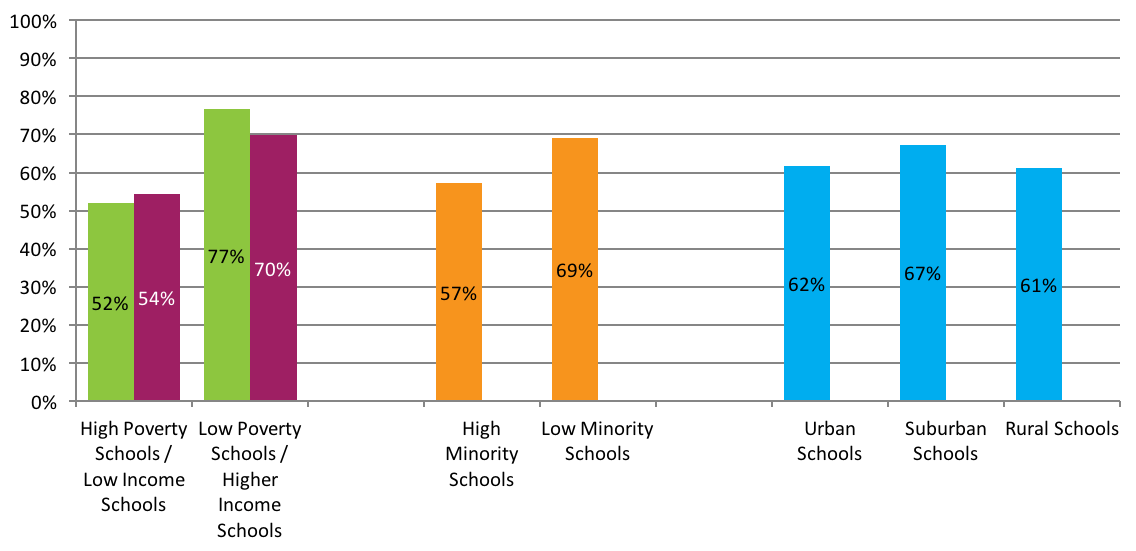
This figure is based on data shown in Appendix C, Table 1
Immediate college enrollment is one of the many important measures that high schools use to assess their impact on student academic success. Figure A shows the rates of immediate college enrollment in the first fall after high school graduation for the class of 2016 by different school characteristics. Income was the strongest correlate with immediate college enrollment. Students from higher income schools were more likely to enroll immediately than students from lower income schools (70 percent and 54 percent, respectively). The gap became even larger when we examined this outcome for graduates of high-poverty schools (where at least 75 percent of the student population was eligible for a free or reduced-price lunch, or FRPL) and low-poverty schools (where less than 25 percent of their student population was eligible for FRPL). A 25 percentage point difference exists between high- and low-poverty schools (52 percent and 77 percent, respectively).
The school minority level was also a strong correlate. Students from low minority high schools were more likely to enroll immediately than those from high schools with higher minority populations (69 percent and 57 percent, respectively). Location was not as strongly correlated, but still demonstrated some relationship with immediate college enrollment. Students from suburban schools (67 percent) were more likely to immediately enroll than those from urban (62 percent) or rural (61 percent) schools.
These patterns are consistent for both graduating classes (2015 and 2016) examined in this report and when the data are expanded to include students who delay their enrollment until the spring and summer terms (enrollment in the first year) or the following year (enrollment in the first two years) (see Appendix C, Tables 2-5). Across all groups, enrollment rates increased markedly when we counted all enrollments in the first two years after graduation, compared to the first fall enrollments (about four percentage points, on average from the first fall enrollment to the first year enrollment and another four percentage points, from the first year to the first two years after graduation). Students attending two-year institutions drove most of the increases, which is not surprising as two-year institutions generally allow more flexibility in start times.
Enrollments at out-of-state institutions were higher for students from higher income and low minority high schools. Sixteen percent of the college-going graduates from higher income schools enrolled at out-of-state institutions, compared to just five percent of those from low income high schools. Sixteen percent of graduates from low minority high schools enrolled in an out-of-state institution, compared to just 7 percent of graduates from high minority high schools (see Appendix C, Table 1).
Persistence
Figure B. Persistence Rates from First to Second Year of College, Class of 2014, Public Non-Charter Schools
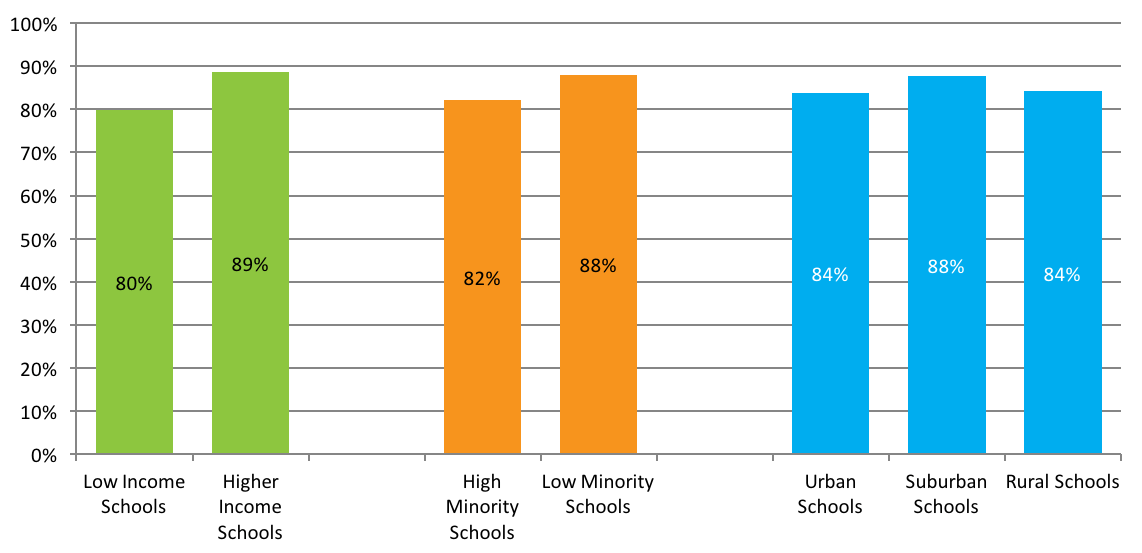
This figure is based on data shown in Appendix C, Table 7
Figure B presents persistence rates from first to second year of college, disaggregated by high school characteristics, for the high school graduating class of 2014. Persistence rate is the percentage of students who returned to college (anywhere) at any time in the second year out of all students from the high school graduating class who enrolled at any time in the first year. Persistence rates for students from different types of high schools ranged from 80 to 89 percent. As with enrollment, the percentage of low-income students in a school was the strongest correlate with persistence. Eighty-nine percent of college-bound students from higher income high schools remained enrolled in their second year, compared to 80 percent from low income high schools. The percentage of minority students in a school was also a strong correlate. Students from low minority high schools had higher rates of persistence (88 percent) than those from high minority high schools (82 percent). High school location was not as strongly correlated with persistence though students from suburban high schools (88 percent) were more likely to return for their second year of college than those from rural (84 percent) and urban (84 percent) high schools.
Regardless of high school type, persistence rates among students who enrolled in private colleges and universities were higher than those in public institutions. Persistence rates for all students were also higher in four-year institutions than in two-year institutions and at out-of-state institutions versus in-state institutions (see Appendix C, Table 7).
Completion
Figure C. College Completion Rates Six Years after High School Graduation, Class of 2010, Public Non-Charter Schools
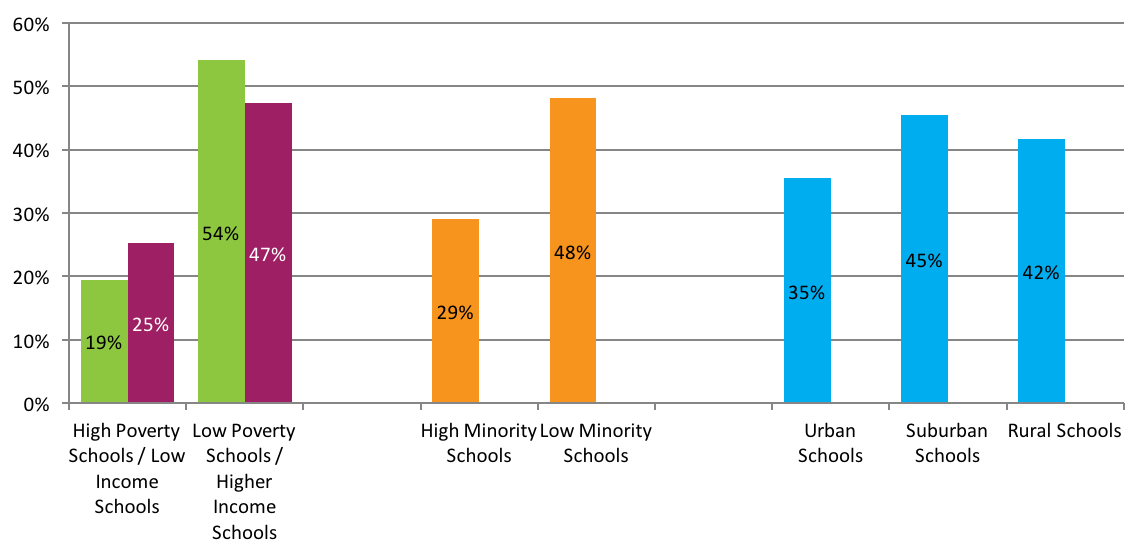
This figure is based on data shown in Appendix C, Table 8
The differences among students from different types of high schools become most pronounced in the rates of college completion. Figure C presents the rates of college completion as a percentage of all students in the high school graduating class, not just those who enrolled in college. Again, income is the strongest correlate. Forty-seven percent of all students from higher income high schools in the class of 2010 completed a college degree within six years of their graduation, compared to 25 percent of students from low income schools. The gap is even larger among graduates of high- and low-poverty schools. Only 19 percent of graduates from high-poverty high schools graduated college within six years of finishing high school, compared to 54 percent of low poverty school graduates.
The relationship between college completion rates and the minority level of the school was equally strong. Forty-eight percent of students from low minority high schools completed a college degree within six years, compared to only 29 percent from high minority schools. Students from urban high schools also lagged behind: 35 percent of students from urban schools completed a degree within six years of graduation, compared to 42 percent from rural schools and 45 percent from suburban schools.
Enrollment and Completion Rates by School Minority and Income Levels
Figure D. College Enrollment Rates in the First Fall after High School Graduation, Class of 2016, Public Non- Charter Schools, by Minority and Income Levels

This figure is based on data shown in Appendix C, Table 11
Figure E. College Completion Rates Six Years after High School Graduation, Class of 2010, Public Non-Charter Schools, by Minority and Income Levels
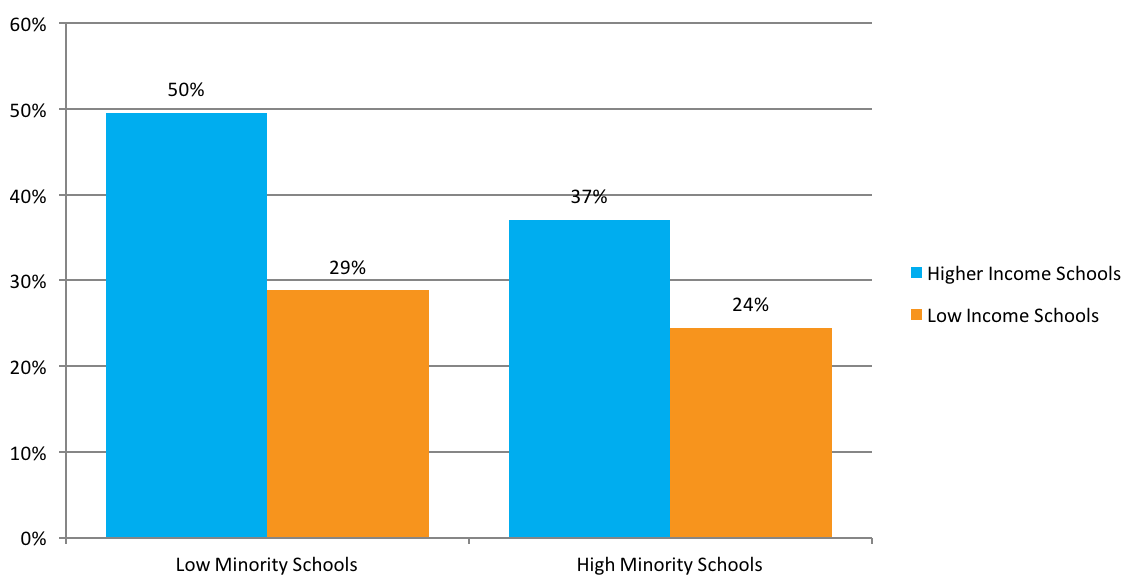
This figure is based on data shown in Appendix C, Table 12
Figures D and E show postsecondary enrollment and completion rates by school minority and income levels combined. The results show that graduates from low minority and low income high schools had the lowest rate of immediate college enrollment (53 percent), a gap of 18 percentage points from the highest rate (71percent), observed for students from low minority, higher income high schools. Further, the outcome differences between higher and low income levels, within each minority level, were substantially larger than the outcome differences between high and low minority levels, within income. For example, in Figure D, the difference in enrollment rate by income levels while keeping the minority status unchanged (e.g., within low minority schools, 71 percent enrollment rate for higher income schools versus 53 percent for low income schools) is substantially larger than the difference in enrollment rate by minority levels while keeping the income level constant (e.g., within higher income schools, low minority schools’ 71 percent enrollment rate versus high minority schools’ 65 percent enrollment rate). In terms of six-year college completion rates, graduates from high minority and low income high schools had the lowest rate (24 percent), a gap of 26 percentage points from the highest rate (50 percent), observed for students from low minority, higher income high schools (Figure E).
Top Categories of Majors at Immediate College Enrollment and at Completion
In these analyses, we examined the patterns of majors at immediate college enrollment and at completion for those* who enrolled in or completed a degree from two year or four year schools separately. The results of these analyses are presented in Appendix C. It is important to note that the graduating classes used to compare majors at immediate college enrollment versus majors at completion were not the same. Specifically, the high school class of 2016 was used to examine majors at enrollment whereas the high school class of 2010 was used to examine majors at completion.
When examining the most common categories of majors for graduates of low income and higher income high schools, the results showed that overall, there were only small changes in the most common types of majors declared at first enrollment in two-year institutions and the most common types of majors students graduated with from two-year institutions. The most common majors at both first enrollment and completion were in the categories of liberal arts and sciences, general studies and humanities followed by categories of health professions, and business.
For the four-year sector, the results showed that the most common majors declared at immediate college enrollment, regardless of whether the student graduated from higher income or low income high schools, was in the liberal arts and sciences, general studies and humanities category. The most common majors at completion, however, was in the business, management, marketing, and related support category. In fact, liberal arts and sciences was not among the top five categories of majors for completions. The results also revealed that during enrollment, engineering was one of the top five majors for graduates of both higher income and low income high schools. However, at completion, social sciences became the second most common major category and only graduates from higher income schools had engineering as one of their top five most common majors.
*Majors, for students first enrollment were mapped to the NCES’ Classification of Instructional Programs (CIP) code. NCES classifies instructional programs by a six-digit CIP code at the most granular level and organizes them into CIP families by their two-digit prefix.
STEM Completion
Figure F. College Completion Rates Six Years after High School Graduation, STEM Field of Study, Class of 2010, Public Non-Charter Schools
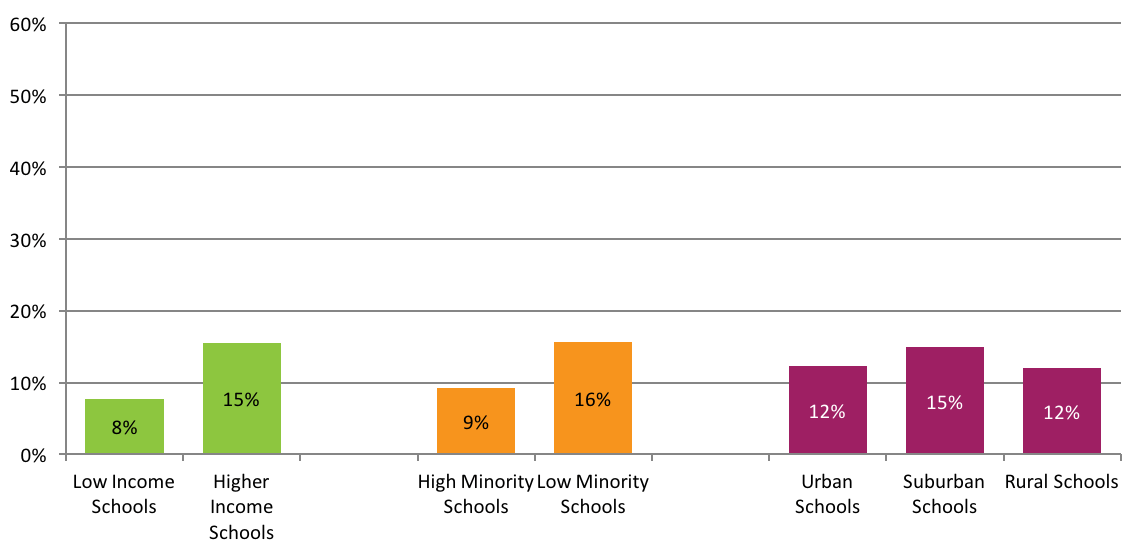
This figure is based on data shown in Appendix C, Table 9
Figure F presents the rates at which graduates from different types of high schools in the class of 2010 completed a STEM degree within six years of high school graduation.1 The percentages of both minority and low-income students in a school were strongly associated with STEM degree completion. Fifteen percent of students from higher income schools, but only eight percent of students from low income schools, completed STEM degrees within six years of high school graduation. Similarly, 16 percent of students from low minority high schools completed a STEM degree within six years, compared to nine percent of students from high minority schools. The relationship between high school location and STEM degree completion was less pronounced. Fifteen percent of students from suburban high schools completed STEM degrees, compared to 12 percent of students from both rural and urban high schools.
1Figure F presents the number students attaining degrees as a percentage of the number that graduated high school. The definition of STEM used in this analysis is based on a listing of six-digit CIP codes used by the National Science Foundation and includes social sciences and psychology (for a complete list, see Appendix A).
Figure G. Distribution of Fields of Study among STEM Completers, Class of 2010, Public Non-Charter Schools
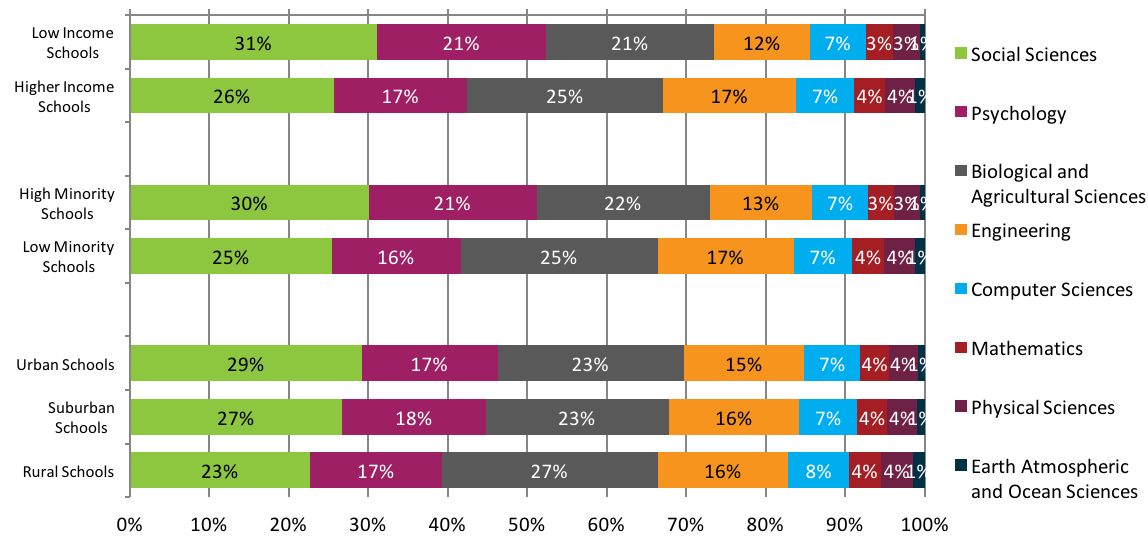
This figure is based on data shown in Appendix C, Table 10
Figure G shows STEM degree completion by field of study and reveals further patterns of disparities among students from different types of high schools, within the group of STEM completers. The majority of STEM degrees for students from both low income (52 percent) and high minority (51 percent) high schools are awarded in either psychology or the social sciences, compared to 43 percent for those from higher income and 41 percent for those from low minority schools. Students from higher income and low minority schools who completed STEM degrees were more likely to do so in physical sciences, mathematics, engineering, and biological and agricultural sciences than students from low income and high minority schools.
Observations Based on All National Results
The results strongly suggest that achievement gaps, based on the type of high school that students graduate from, exist in college enrollment, persistence, completion, and STEM completion. Students who attend high schools that serve low income or high minority populations are less likely to start college than their peers from higher income and low minority schools. Those who do enroll appear to fall further behind as time passes becoming less likely to graduate. The difference or gap in enrollment and completion rates by school income levels are much larger than school minority levels. Students from disadvantaged high schools who do graduate from college are less likely to earn a degree in a STEM major, particularly in engineering and biological sciences.
Section 2: Results by High School Type, (for Use by Individual High Schools)
Guidance on How to Interpret the Outcomes in this Section
This section provides detailed results for schools in low income and higher income categories as well as in high poverty and low poverty categories. Section 2 is intended for use by individual high schools as benchmarks against which to compare their own results.
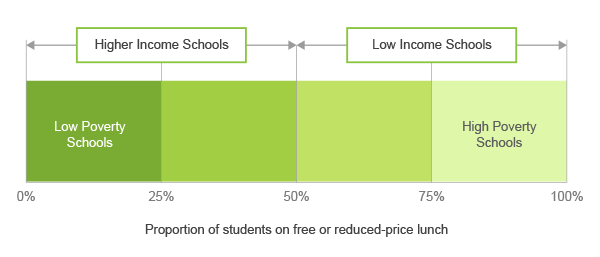
Outcomes are provided in two different ways: student-weighted totals and school percentile distributions.
Tables with student-weighted totals are designed to enable individual schools and districts to compare their StudentTracker results directly to the national benchmarks. Totals are calculated by computing the mean among all schools within the category, weighted by the size of each school’s graduating class. By placing their own results into the context of these aggregate totals, practitioners can better understand the meaning of their students’ college access and persistence outcomes.
Tables with school percentile distributions are designed to enable individual schools and districts to identify the approximate percentile rank of their students’ college-going rate. These distributions are calculated by ranking schools on outcome without considering school size or number of graduates. Thus, if a school’s college-going rate is the same as the rate at the 75th percentile, the school is said to have a college-going rate equal to or higher than that of 75 percent of all StudentTracker schools in that category.
Results Tables & Figures
Results Tables & Figures
References
Bell, A. D., Rowan-Kenyon, H.T., & Perna, L.W. (2009). College knowledge of 9th and 11th grade students: Variation by school and state context. The Journal of Higher Education 80(6), 663‐685.
Berliner, D. C. (2017). Poverty’s powerful effects on reading achievement and the achievement gap. In R. Horowitz & S. J. Samuels (Eds.), The achievement gap in reading: Complex causes, persistent issues, possible solutions (pp. 23-37), New York and London: Routledge/Taylor & Francis.
Black, S.E., Lincove J.A., Cullinane, J., & Veron R. (2014). Can you leave high school behind? Retrieved from National Bureau of Economic Research website http://www.nber.org/papers/w19842
Burney, V. H., & Beilke, J. R. (2008). The constraints of poverty on high achievement. Journal for the Education of the Gifted, 31(3), 171-197.
CLASP. (June 2015). Course, counselor, and teacher gaps: Addressing the college readiness challenge in high poverty high schools. Retrieved from https://www.clasp.org/blog/addressing-college-readiness-challenge-high-poverty-schools/
DeBerard, M. S, Spielmans, G. I., & Julka. D. C. (2012). Predictors of academic achievement and retention among college freshmen: A longitudinal study. College Student Journal, 38(1), 66-80.
Kofoed, M. S. (2017). To apply or not to apply: FAFSA completion and financial aid gaps. Research in Higher Education, 58(1), 1-39.
Hossler, D, Schmit, J. and Vesper, N. (1999). Going to college: How social, economic, and educational factors influence the decisions students make. Baltimore, MD: The Johns Hopkins University Press.
McFarland, J., Hussar, B., de Brey, C., Snyder, T., Wang, X., Wilkinson-Flicker, S., Gebrekristos, S., Zhang, J., Rathbun, A., Barmer, A., Bullock Mann, F., & Hinz, S. (2017). The Condition of Education 2017 (NCES 2017-144). U.S. Department of Education, National Center for Education Statistics. Washington, DC. Retrieved from https://nces.ed.gov/pubsearch/pubsinfo.asp?pubid=2017144
Nienhusser, H. K., & Oshio, T. (2017). High school students’ accuracy in estimating cost of college: A proposed methodological approach and differences among racial/ethnic groups and college financial-related factors. Research in Higher Education, 58(1), 1-23.
Appendix A: Methodological Notes
This report contains college enrollment, persistence and completion outcomes for high school graduating classes of 2010, 2013, 2014, 2015, and 2016. The results presented in the report center on the following outcomes:
- College enrollment in the
- first fall after high school graduation;
- first year after high school graduation; and
- first two years after high school graduation
- Persistence from the first to the second year of college.
- College completion within six years after high school graduation.
The outcomes are presented by type of college attended, including public and private institutions, two-year and four-year institutions, and in-state and out-of-state institutions. These characteristics are defined by IPEDS Institutional Characteristics data as of 2014-15. In-state designations are defined relative to the state in which the high school is located, not the residency of individual students.
The high school dataset used for this report is based on a voluntary sample and is not a nationally representative sample of schools or of high school graduates. High school diploma data are submitted to the National Student Clearinghouse (the Clearinghouse) by schools and districts that participate in the StudentTracker for High Schools (STHS) service. High schools participating in this service pay a small fee (typically $425) to receive a packet of reports with postsecondary access and success outcomes for their graduating classes. In general, the participating schools tend to have greater representation among schools with high minority enrollments and in urban locales.
This report is based on the data submitted to the Clearinghouse on graduating classes of 2010, 2013, 2014, 2015, and 2016. Table A1 below shows the number of participating high schools and high school graduates included in this report compared to the total number of US high schools and high school graduates. All types of high schools, including both public and private schools, participate in the Clearinghouse STHS service.
Table A1. Number of public, non-charter high schools and public, non-charter high school graduates included in the report
| Academic year1 | Number of Participating High Schools | Percent of All U.S. Public High Schools2 | Percent of U.S. Grade 12 Enrollment Represented3 | Total N (Number of Graduates in Participating High Schools) |
| 2009-2010 | 4,856 | 29% | 39% | 1,128,544 |
| 2012-2013 | 5,393 | 32% | 42% | 1,221,724 |
| 2013-2014 | 5,513 | 33% | 42% | 1,225,065 |
| 2014-2015 | 5,322 | 31% | 40% | 1,161,142 |
| 2015-2016 | 5,085 | 30% | 38% | 1,106,564 |
1Academic year is defined as the period between September 1-August 31.
2 The total number of schools used in the denominator of this calculation was obtained from NCES’ Elementary and Secondary Information System (ELSi). The public school information is available from the Common Core of Data through 2014-15. The number of public, non-charter schools for 2015-16 is an estimate, equal to the number from 2014-15.
3 The numbers used in both the denominator and numerator of this calculation were obtained from NCES’ Elementary and Secondary Information System (ELSi). Grade 12 enrollment information is available from the Common Core of Data through 2014-15. The numbers for 2015-16 are estimates, equal to the numbers from 2014-15.
Table A2. Number of public, charter high schools and public, charter high school graduates included in the report
| Academic year1 | Number of Participating High Schools | Percent of All U.S. Public High Schools2 | Percent of U.S. Grade 12 Enrollment Represented3 | Total N (Number of Graduates in Participating High Schools) |
| 2009-2010 | 327 | 23% | 28% | 22,815 |
| 2012-2013 | 453 | 25% | 34% | 37,601 |
| 2013-2014 | 488 | 25% | 35% | 42,210 |
| 2014-2015 | 473 | 23% | 35% | 43,067 |
| 2015-2016 | 404 | 20% | 27% | 36,441 |
1Academic year is defined as the period between September 1-August 31.
2 The total number of schools used in the denominator of this calculation was obtained from NCES’ Elementary and Secondary Information System (ELSi). The public school information is available from the Common Core of Data through 2014-15. The number of public, charter schools for 2015-16 is an estimate, equal to the number from 2014-15.
3 The numbers used in both the denominator and numerator of this calculation were obtained from NCES’ Elementary and Secondary Information System (ELSi). Grade 12 enrollment information is available from the Common Core of Data through 2014-15. The numbers for 2015-16 are estimates, equal to the numbers from 2014-15.
Table A3. Number of private high schools and private high school graduates included in the report
| Academic year1 | Number of Participating High Schools | Percent of All U.S. Private High Schools2 | Percent of U.S. Grade 12 Enrollment Represented3 | Total N (Number of Graduates in Participating High Schools) |
| 2009-2010 | 326 | 5% | 17% | 45,828 |
| 2012-2013 | 344 | 6% | 18% | 43,948 |
| 2013-2014 | 308 | 6% | 16% | 38,670 |
| 2014-2015 | 259 | 5% | 14% | 32,270 |
| 2015-2016 | 182 | 3% | 9% | 21,738 |
1Academic year is defined as the period between September 1-August 31.
2 The total number of schools used in the denominator of this calculation was obtained from NCES’ Elementary and Secondary Information System (ELSi). The private school information is available from the Private School Survey, which is collected every two years through 2013-14. The number of private schools for 2012-13, 2014-15, and 2015-16 are estimates, equal to the number from the previous available year
3 The numbers used in both the denominator and numerator of this calculation were obtained from NCES’ Elementary and Secondary Information System (ELSi). Grade 12 enrollment information is available from the Private School Survey, which is collected every two years through 2013-14. The numbers for 2012-13, 2014-15, and 2015-16 are estimates, equal to the numbers from the previous available year.
Definitions of Public, Non-Charter High School Categories
We used the Common Core of Data (CCD) to construct the sampling frame of schools. The CCD is the Department of Education’s primary database on public elementary and secondary education in the United States. From the CCD, we created a sample frame that contains all regular public schools with a 12th grade.
In order to enable public, non-charter high schools to compare their own outcomes with those of similar high schools, the outcomes in this report are presented on the basis of school-level characteristics: low income and higher income; high minority and low minority; and urban, suburban, or rural. Membership in these categories for each academic year is based on CCD data for the corresponding year with one exception: for the academic year of 2015-2016, the categories are based on the information from the same source for 2014-2015.
Low income schools are defined as schools where at least 50 percent of the entire student population (not just graduating seniors) is eligible for free or reduced price lunch. Minority schools are defined as those schools where at least 40 percent of the students are Black or Hispanic. Locale is defined by the NCES urban-centric locale code. Schools with a code from 11 to 13 are defined as urban. Schools with a code from 21 to 23 are defined as suburban. And those with a code 31 to 43, covering both town and rural areas, are defined as rural.
Combinations of these characteristics resulted in nine groups of high schools. Thus, the outcomes are presented for the following categories of high schools:
- Low income schools
- Higher income schools
- Low minority schools
- High minority schools
- Urban schools
- Suburban schools
- Rural schools
Table A4. Number of public, non-charter high schools and public, non-charter high school graduates included in the report by category of high schools
| Group | Academic year | Number of Participating High Schools | Percent of U.S. Grade 12 Enrollment Represented | # of States Represented | Total N (Number of Graduates in Sample) |
| Low Income Schools | 2009-2010 | 1,447 | 40% | 46 | 311,078 |
| 2012-2013 | 1,980 | 41% | 48 | 421,865 | |
| 2013-2014 | 2,061 | 41% | 48 | 438,948 | |
| 2014-2015 | 2,001 | 39% | 46 | 427,811 | |
| 2015-2016 | 1,900 | 37% | 45 | 405,502 | |
| Higher Income Schools | 2009-2010 | 3,409 | 39% | 51 | 817,466 |
| 2012-2013 | 3,413 | 43% | 51 | 799,859 | |
| 2013-2014 | 3,452 | 44% | 50 | 786,117 | |
| 2014-2015 | 3,321 | 41% | 49 | 733,331 | |
| 2015-2016 | 3,185 | 39% | 48 | 701,062 | |
| High Minority Schools | 2009-2010 | 1,416 | 45% | 41 | 408,681 |
| 2012-2013 | 1,703 | 48% | 41 | 477,027 | |
| 2013-2014 | 1,727 | 48% | 43 | 490,984 | |
| 2014-2015 | 1,683 | 46% | 39 | 477,796 | |
| 2015-2016 | 1,586 | 43% | 37 | 455,469 | |
| Low Minority Schools | 2009-2010 | 3,440 | 37% | 49 | 719,863 |
| 2012-2013 | 3,690 | 39% | 50 | 744,697 | |
| 2013-2014 | 3,786 | 39% | 50 | 734,081 | |
| 2014-2015 | 3,639 | 37% | 49 | 683,346 | |
| 2015-2016 | 3,499 | 35% | 49 | 651,095 | |
| Urban Schools | 2009-2010 | 1,355 | 52% | 48 | 377,020 |
| 2012-2013 | 1,549 | 56% | 50 | 425,207 | |
| 2013-2014 | 1,535 | 56% | 49 | 421,494 | |
| 2014-2015 | 1,470 | 53% | 49 | 404,838 | |
| 2015-2016 | 1,424 | 51% | 46 | 395,077 | |
| Suburban Schools | 2009-2010 | 1,337 | 46% | 45 | 475,431 |
| 2012-2013 | 1,628 | 47% | 45 | 570,699 | |
| 2013-2014 | 1,640 | 47% | 46 | 571,471 | |
| 2014-2015 | 1,547 | 45% | 44 | 535,680 | |
| 2015-2016 | 1,434 | 41% | 45 | 500,486 | |
| Rural Schools | 2009-2010 | 2,164 | 25% | 48 | 276,093 |
| 2012-2013 | 2,216 | 24% | 49 | 225,818 | |
| 2013-2014 | 2,338 | 25% | 49 | 232,100 | |
| 2014-2015 | 2,305 | 24% | 47 | 220,624 | |
| 2015-2016 | 2,227 | 23% | 48 | 211,001 |
The numbers used in both the denominator and numerator of this calculation were obtained from NCES’ Elementary and Secondary Information System (ELSi). The denominator is the number of grade 12 enrollments for all schools in a particular category of high schools. The numerator is the number of grade 12 enrollments for participating public high schools in the category. Grade 12 enrollment information is available from the Common Core of Data through 2014-15. The numbers for 2015- 16 are estimates, equal to the numbers from 2014-15.
In addition to our standard results for schools in low income and higher income categories, the report also presents postsecondary outcomes for graduates from a subset of low income schools defined as high-poverty schools and a subset of higher income schools defined as low-poverty schools. High-poverty schools are defined as those where at least 75 percent of the student population is eligible for free or reduced price lunch. Low-poverty schools are defined as those where less than 25 percent of the student population is eligible for free or reduced price lunch.
Table A5. Number of public, non-charter high schools and public, non-charter high school graduates in high poverty and low poverty schools included in the report by category
| Group | Academic Year | Number of Participating High Schools | Percent of U.S. Grade 12 Enrollment Represented | # of States Represented | Total N (Number of Graduates in Sample) |
| High Poverty Schools | 2009-2010 | 516 | 46% | 34 | 90,221 |
| 2012-2013 | 789 | 46% | 42 | 145,510 | |
| 2013-2014 | 873 | 47% | 42 | 164,592 | |
| 2014-2015 | 853 | 45% | 42 | 160,001 | |
| 2015-2016 | 819 | 43% | 38 | 155,425 | |
| Low Poverty Schools | 2009-2010 | 1,502 | 46% | 50 | 438,771 |
| 2012-2013 | 1,370 | 50% | 49 | 394,491 | |
| 2013-2014 | 1,349 | 50% | 49 | 383,203 | |
| 2014-2015 | 1,293 | 47% | 47 | 350,795 | |
| 2015-2016 | 1,223 | 44% | 47 | 331,368 |
The numbers used in both the denominator and numerator of this calculation were obtained from NCES’ Elementary and Secondary Information System (ELSi). The denominator is the number of grade 12 enrollments for all schools in a particular category of high schools. The numerator is the number of grade 12 enrollments for participating public high schools in the category. Grade 12 enrollment information is available from the Common Core of Data through 2014-15. The numbers for 2015- 16 are estimates, equal to the numbers from 2014-15.
Postsecondary Data
College enrollment, persistence, and completion outcomes are determined by matching the graduate files received from high schools each year, to the postsecondary enrollment data held by the National Student Clearinghouse. The National Student Clearinghouse is a unique and trusted source for higher education enrollment and degree verification. Currently, Clearinghouse data include more than 3,600 postsecondary institutions and 97 percent of U.S. postsecondary enrollments (for detailed coverage of postsecondary enrollments, see Appendix B). Because the database is comprised of student-level data, researchers can use it to link concurrent as well as consecutive enrollments of individual students at multiple institutions — a capability that distinguishes the Clearinghouse data from national databases built with institution-level data.
In order to preserve comparability to the reports that schools and districts receive on their graduates’ college access, persistence, and completion rates through the Clearinghouse’s StudentTracker service, results have not been adjusted to account for a student’s outcome not being captured due to noncoverage by Clearinghouse data.
Definitions of Outcomes
College enrollment in the first fall after high school graduation: Percentage of high school students who enrolled in a two- or four-year postsecondary institution in the fall semester immediately following graduation. The fall semester immediately following graduation is defined as any enrollment that occurs between August 15 and October 31.
College enrollment in the first year after high school graduation: Percentage of high school students who enrolled in a two- or four-year postsecondary institution in the academic year immediately following graduation. The first year after high school includes any enrollment that occurs between August 15 of the graduation year and August 14 of the following year.
College enrollment in the first two years after high school graduation: Percentage of high school students who enrolled in a twoor four-year postsecondary institution in the first two years following graduation. The first two years after high school includes any enrollment that occurs between August 15 of the graduation year and August 14 of the second year.
Persistence from first to second year of college: Percentage of students enrolled in the first year after high school graduation who remained enrolled in postsecondary education in the second year. This is the percentage of students who re-enrolled at any postsecondary institution, not necessarily the same one they started in. Thus, it is different from the typical measure of retention at the same institution.
College completion within six years after high school graduation: Percentage of high school students who attained a degree in a two- or four-year postsecondary institution in the six academic years immediately following graduation. Only associate, bachelors, and advanced degrees are counted in these rates. Certificates are not included.
STEM College Completions
Analysis is based on degree records that were awarded to students within six years of high school graduation. Only associate, bachelors, and advanced degrees are considered. Certificates are not included. The field of study, whenever reported by the postsecondary institution, is mapped to the NCES’ Classification of Instructional Programs (CIP) code. NCES classifies instructional programs by a six-digit CIP code at the most granular level and organizes them into CIP families by their two-digit prefix.
The definition of STEM (science, technology, engineering, and math) used in this analysis is based on a listing of six-digit CIP codes used by the National Science Foundation, and it includes the following disciplines:
- Biological and Agricultural Sciences
- Computer Sciences
- Earth, Atmospheric, and Ocean Sciences
- Engineering
- Mathematics
- Physical Sciences
- Psychology
- Social Sciences
If a student is awarded more than one degree and at least one of them is in a STEM discipline, the earliest STEM degree is considered for this analysis.
Appendix B: Postsecondary Coverage Tables
> Download Postsecondary Coverage Tables (.xlsx)
